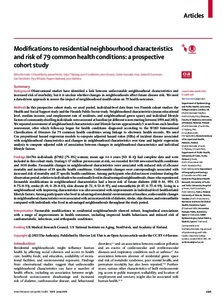Modifications to residential neighbourhood characteristics and risk of 79 common health conditions: a prospective cohort study
Gonzales-Inca Carlos; Batty G David; Ervasti Jenni; Dadvand Payam; Lindbohm Joni V; Suominen Sakari B; Nyberg Solja T; Pentti Jaana; Kivimäki Mika; Sipilä Pyry N; Stenholm Sari; Vahtera Jussi
Modifications to residential neighbourhood characteristics and risk of 79 common health conditions: a prospective cohort study
Gonzales-Inca Carlos
Batty G David
Ervasti Jenni
Dadvand Payam
Lindbohm Joni V
Suominen Sakari B
Nyberg Solja T
Pentti Jaana
Kivimäki Mika
Sipilä Pyry N
Stenholm Sari
Vahtera Jussi
ELSEVIER SCI LTD
Julkaisun pysyvä osoite on:
https://urn.fi/URN:NBN:fi-fe2021100750345
https://urn.fi/URN:NBN:fi-fe2021100750345
Tiivistelmä
Background
Observational studies have identified a link between unfavourable neighbourhood characteristics and increased risk of morbidity, but it is unclear whether changes in neighbourhoods affect future disease risk. We used a data-driven approach to assess the impact of neighbourhood modification on 79 health outcomes.
Methods
In this prospective cohort study, we used pooled, individual-level data from two Finnish cohort studies: the Health and Social Support study and the Finnish Public Sector study. Neighbourhood characteristics (mean educational level, median income, and employment rate of residents, and neighbourhood green space) and individual lifestyle factors of community-dwelling individuals were assessed at baseline (at different waves starting between 1998 and 2013). We repeated assessment of neighbourhood characteristics and lifestyle factors approximately 5 years from each baseline assessment, after which follow-up began for health conditions diagnosed according to the WHO International Classification of Diseases for 79 common health conditions using linkage to electronic health records. We used Cox proportional hazard regression models to compute adjusted hazard ratios (HRs) of incident disease associated with neighbourhood characteristics and changes in neighbourhood characteristics over time and logistic regression analysis to compute adjusted odds of association between changes in neighbourhood characteristics and individual lifestyle factors.
Findings
114786 individuals (87012 [75.8%] women; mean age 44.4 years [SD 11.1]) had complete data and were included in this cohort study. During 1.17 million person-years at risk, we recorded 164368 new-onset health conditions and 3438 deaths. Favourable changes in neighbourhood characteristics were associated with reduced risk of all-cause mortality and incidence of 19 specific health conditions. Unfavourable changes were correspondingly associated with increased risk of mortality and 27 specific health conditions. Among participants who did not move residence during the observation period, relative to individuals who continually lived in disadvantaged neighbourhoods, those who experienced favourable modifications in neighbourhood characteristics had a lower risk of future diabetes (HR 0.84, 95% CI 0.75-0.93), stroke (0.49, 0. 29-0.83), skin disease (0.72,0.53-0. 97), and osteoarthritis (0.87, 0.77-0.99). Living in a neighbourhood with improving characteristics was also associated with improvements in individual-level health-related lifestyle factors. Among participants who lived in advantaged residential environments at baseline, unfavourable changes in neighbourhood characteristics were associated with an increased risk of diabetes, stroke, skin disease, and osteoarthritis compared with individuals who lived in advantaged neighbourhoods throughout the study period.
Interpretation
Favourable modifications to residential neighbourhoods showed robust, longitudinal associations with a range of improvements in health outcomes, including improved health behaviours and reduced risk of cardiometabolic, infectious, and orthopaedic conditions.
Kokoelmat
- Rinnakkaistallenteet [27094]
